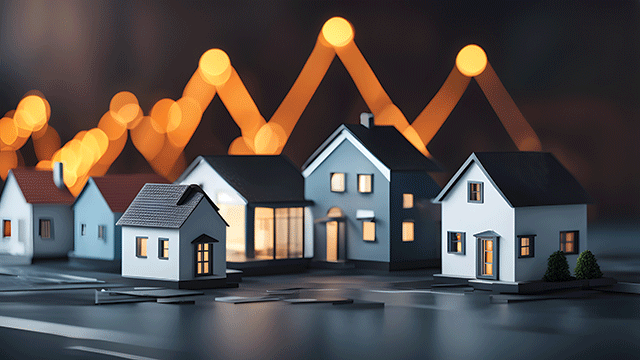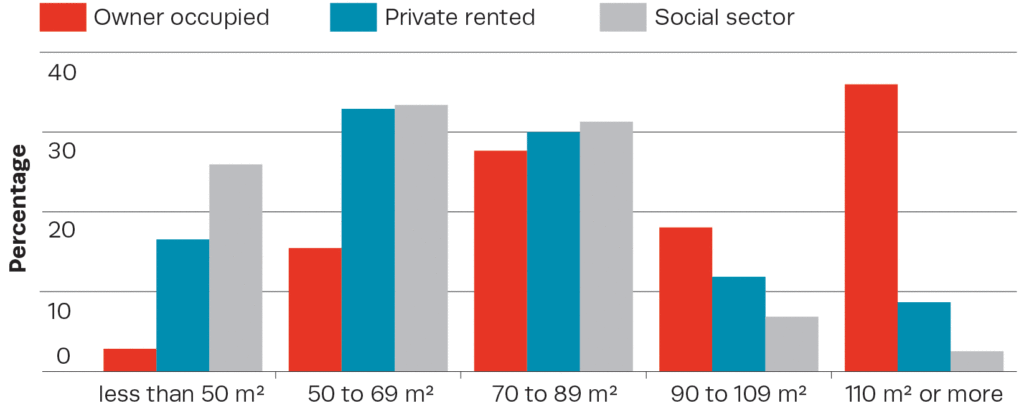Housing comes in all shapes and sizes. Some are single-storey and small, such as a bungalow, and others are huge, like the Landmark Pinnacle in London, which rises 75 storeys, making it the tallest residential tower in the UK. In the quick quiz at the end of this article there will be some dwelling-size questions posed, with answers at the end of the quiz box. Sizes will be quoted variously in metric and imperial, as it is very important for future property professionals to be familiar with both. For calculation purposes, 1 sq m = 10.764 sq ft and 1 sq ft = 0.0929 sq m.
Academic staff across the sector have witnessed many rookie errors among students who have got the two mixed up in presentations and examinations, with disastrous results. Confidently being able to think, measure and report in both will be essential in practice and quite possibly in your assessment of professional competence on your way to becoming a professional or licenced practitioner.
How big is the average UK home?
A government survey carried out in 2018-19 found that in England the average home, based on internal areas (excluding garages and balconies), was 94 sq m. In doing so, it found, in general, owner-occupied dwellings were larger than rented dwellings: 108 sq m for owner-occupied, compared with 75 sq m for private rented and 66 sq m for social housing rented. London also had a lower average size compared to elsewhere in England, in large part due to the higher proportion of flats in its housing stock.
Following this, the government English Housing Survey 2023-24 found the average home had increased to 96 sq m, with owner-occupied at 110 sq m. Private and social rented remained the same.
Government surveys of Scottish dwellings indicate they are, on average, larger than English homes, at around 128 sq m, Wales just less at about 121 sq m and Northern Ireland even less at 98 sq m. Republic of Ireland average housing stock size appears to be broadly similar to the UK, but slightly smaller. There also appears to be some evidence that the average floor size area of all dwellings has been decreasing in recent years, yet at the same time, the average floor size of new dwellings coming to market has increased.
Usable floor area for dwellings by tenure, 2023
Source: English Housing Survey 2023 to 2024, UK government
Comparisons with other countries
Australian homes are the largest, with an average of around 214 sq m, more than twice that of England. Various surveys show that Canadian and US homes are larger on average too. Averages in China and Russia, perhaps not surprisingly, are much smaller than the UK.
Looked at a different way, how much floorspace per person do people have around the world? The independent UK think-tank Resolution Foundation found that in 2018 there was approximately 38 sq m of dwelling space per person across England. The French and Germans were found to have slightly more space per person at 43 sq m and 48 sq m. The Americans, by contrast, have almost twice as much at 66 sq m.
Student accommodation
This is a space that most student readers should be familiar with: new-build student study bedrooms with en suite bathroom accommodation. The dimensions of typical accommodation from the window to front door might typically be close to 5.4m by 2.6m, providing just about enough space for a bed, wardrobe, a fitted desk, a very small table, chair, shower, toilet and basin. Free floor space in the bed-sitting room part of the accommodation might only be about 4 sq m of that space.
What about student accommodation in a shared house (formally called a house in multiple occupation)? The minimum floor area for a single bedroom based on the government standard since October 2018 is 6.51 sq m. This would give a space of 2.6m x 2.5m: room for a single bed against a wall, a small gap at the end, a small chest of drawers, a small wardrobe, a small desk and chair and just about enough space to open the door, but pretty well nothing else. By comparison, that is 1.5 sq m more than the average prison cell, but that’s a topic for a different journal. Please note that there are variations on HMO sizes dependent on the particular local authority area.
Let us imagine you can afford to rent or buy a one-bed flat with your new job on graduation. Dependent on the location, such accommodation might be around 30-45 sq m.
One- and two-storey homes
Now let us examine a range of other more common residential accommodation types and sizes. Starting with a bungalow, the national average floor area is around 860 sq ft/80 sq m. In terms of the overall size range of small to large bungalows, the UK stock is typically between about 800 sq ft to 2,000 sq ft.
By comparison, the national average size of small two-storey, two-bed terraces is around 650-690 sq ft with larger ones up to and around 1,100 sq ft.
Georgian terraced town housing more often had three or four storeys and could range from around 1,200 sq ft to 3,600 sq ft plus, more often or not with a basement.
Going up the scale and switching to metric, a typical two-storey, three-bedroom, semi-detached home is around 90-100 sq m, with larger ones (including an extra bedroom) around 130-150 sq m. Bigger still, a four- or five-bed detached house would be around 200 sq m.
GEA, GIA and linear measurements
So would such house size figures generally be quoted in gross internal area or gross external area? GEA measurements would add approximately 12-15% to the internal size of a dwelling space. Cavity wall thicknesses in typical mid to late 20th century and current new-builds are about 300mm. Solid brick walls of the early 20th century and Victorian period are normally about 240- 260mm thick, including plaster and render.
So what is your answer? Well, it’s GIA, and that is especially the case when you think about multi-storey apartments. However, it is much more likely for sales and letting purposes for rooms to be described in terms of linear measurements rather than GIA.
And, finally, without looking back, how many sq ft are there in a sq m?
‘Guesstimates’, measurements and skill development
For this task, start by guessing the width and depth of your bedroom and other rooms where you live – then measure them and see how close you were (and how different to the national average).
Building up your visual skill in “guesstimating” the dimensions and areas of space is part of becoming a property professional, but don’t forget, if using the RICS Code of Measuring Practice, you measure to the walls, not the skirting board and no higher than 1.5m above the floor (and always sense check your measurements for mistakes).
Multi-storey residential buildings
Up and until the early 20th century, these were typically built up to five or six storeys. After the First World War, flats got higher, rising up to 10 and sometimes more storeys in height. Since the Second World War, through to the present day, the race for the skies has continued apace. It wasn’t just the ability of engineers to design upwardly strong steel and concrete frames instead of load bearing structures that enabled this, but also the upwardly mobile invention of the lift or elevator.
In London, the tallest skyscraper in the UK is the Shard at 309.6m with 72 habitable storeys. This is a mixed-use building with residential on floors 53-65. The tallest wholly residential tower in the UK is the Landmark Pinnacle located in the London Docklands. It is 233m/765ft in height, comprising 75 storeys (though some sources say 76). One-bed suites start at about 39 sq m/415sq ft (three times the size of a typical student en suite bedroom) with larger three-bed apartments of about 109 sq m/1,171sq ft.
The quick quiz
1. Looking across all tenures, how big is the average UK home?
- a) 758 sq ft
- b) 976 sq ft
- c) 1,012 sq ft
- d) 1,298 sq ft
- e) 1,402 sq ft
2. How big are new-build student study bedrooms with en suite bathroom accommodation?
- a) 11.5 sq m
- b) 13.5 sq m
- c) 16.5 sq m
- d) 19.5 sq m
3. Starting with a bungalow, the national average floor area is around 860 sq ft/80 sq m. So how many bedrooms would that size of property typically provide?
- a) One
- b) Two
- c) Three
- d) Four
4. A four- or five-bed detached house would be around 200 sq m. How big is that in imperial measurement?
- a) 1,157 sq ft
- b) 1,525 sq ft
- c) 1,902 sq ft
- d) 2,153 sq ft?
Read the 14 June APC series article for advice on measurement, a practical skill required by most surveyors.
Answers: Q1: c) 1,012 sq ft; Q2: b) 13.5 sq m; Q3: b) Two; Q4: d) 2,153 sq m
Image © Adobe Stock
Follow Estates Gazette











